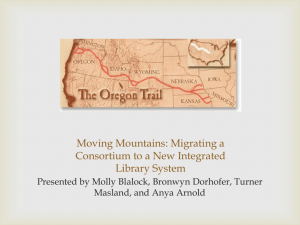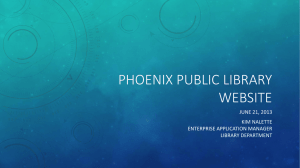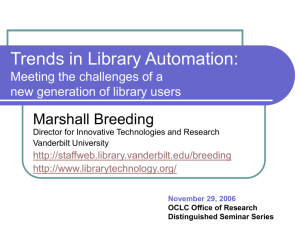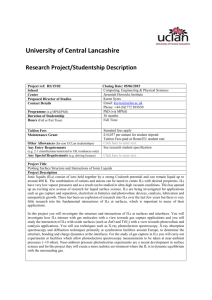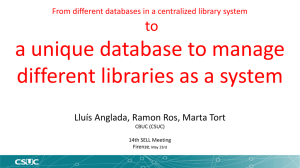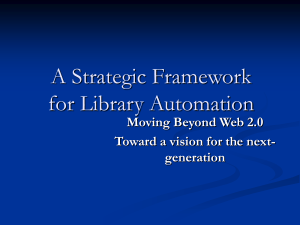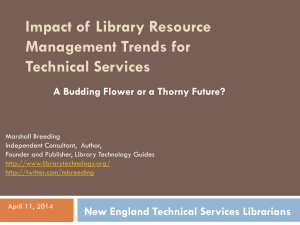Library Automation Challenges for the Next Generation
advertisement
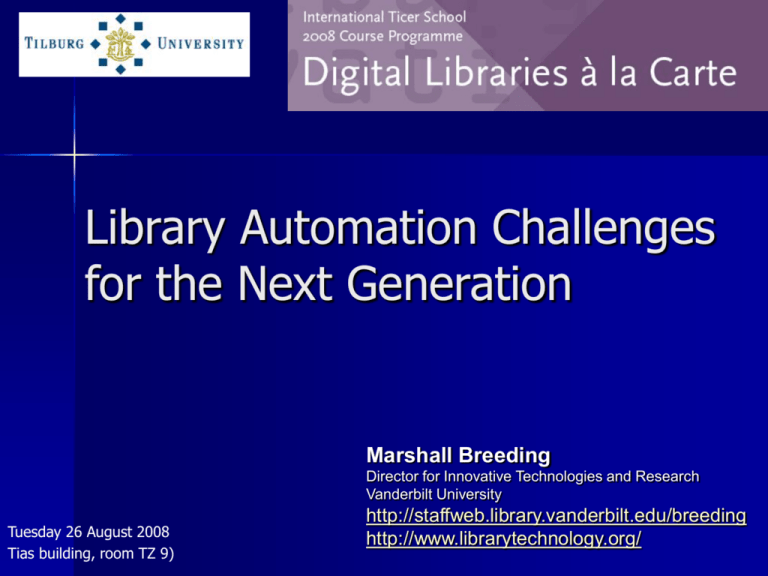
Library Automation Challenges for the Next Generation Marshall Breeding Director for Innovative Technologies and Research Vanderbilt University Tuesday 26 August 2008 Tias building, room TZ 9) http://staffweb.library.vanderbilt.edu/breeding http://www.librarytechnology.org/ Abstract As libraries shift toward collections of ever higher proportions of digital content, automation systems must likewise take a new form. This lecture will review the current state of library automation systems and the business climate among the companies that provide them. Recent rounds of industry consolidation resulted in an uncomfortable narrowing of products from the traditional automation vendors. A harsh business climate contributed to the rise of the open source movement which has introduced a new dynamic in the marketplace. Open source library automation has now entered the mainstream, with support options available from a new breed of companies. Traditional automation vendors face new competition. Libraries themselves have also become involved through initiatives to produce open source products, contributing new alternatives to the mix. A new generation of library interfaces has begun to emerge that promise to put a modern face on the library’s collections and services on the Web. Libraries also demand better tools for managing electronic resources behind-the-scenes, fueling demand for electronic management systems. In broader terms, the molds of the library automation systems in place today were cast decades ago. The presentation will explore the characteristics that a generation of library automation systems built anew for today’s libraries moving forward would embrace. Part I. Broad Industry and Product Trends Upheavals Industry Consolidation Abrupt transitions for major library automation products Increased industry control by external financial investors Demise of the traditional OPAC Frustration with ILS products and vendors Open Source alternatives hit the mainstream Breeding, Marshall: Perceptions 2007 an international survey of library automation. http://www.librarytechnology.org/perceptions2007.pl January 2008. LJ Automation System Marketplace Annual Industry report published in Library Journal 2008: 2007: 2006: 2005: 2004: 2003: 2002: Opportunity out of turmoil An industry redefined Reshuffling the deck Gradual evolution Migration down, innovation up The competition heats up Capturing the migrating customer ILS Industry in Transition Consolidation through mergers and acquisitions have resulted in a fewer number of players; larger companies Uncomfortable level of product narrowing Increased ownership by external interests Yet: Some companies and products continue on solid ground Breeding, Marshall “Automation system marketplace 2008: Opportunity Out of Turmoil” Library Journal. April 1, 2008. Library Automation M&A History Product and Technology Trends Innovation below expectations Conventional ILS less tenable Proliferation of products related to econtent management New genre of discovery-layer interfaces Web 2.0 / Collaborative Computing Currently implemented ad hoc Many libraries putting up blogs, wikis, and fostering engagement in social networking sites Proliferation of silos with no integration or interoperability with larger library Web presence Next Gen: Build social and collaborative features into core automation components Part II. A Mandate for Openness Opportunities for Openness Open Source – Alternative to traditionally licensed software Open Systems – Software that doesn’t hold data hostage Open Content – – – – Open access platforms for scholarly content Institutional Repositories Bibliographic Services (OpenLibrary) Open content communities for tags, cover art, reviews (LibraryThing) – OpenURL / ERMS Knowledgebases? (JAKE) Open Source Alternatives Explosive interest in Open Source driven by disillusionment with current vendors and near-evangelical promotion of this software licensing model Beginning to emerge as a practical option TOC (Total Cost of Ownership) still roughly equal to proprietary A result of industry turmoil Disruptions and business decisions to narrow options have fueled the open source movement Benefit to libraries in having additional options Traditionally licensed and open source ILS alternatives will coexist in the ILS arena Open Source ILS enters the mainstream Earlier era of pioneering efforts to ILS shifting into one where open source alternatives fall in the mainstream Off-the-shelf, commercially supported product available Still a minority player, but gaining ground Open Source ILS options Koha – Commercial support from LibLime Evergreen – Commercial support from Equinox Software OPALS – Commercial support from Media Flex NewGenLib – Open Source ILS for the developing world Business case for Open Source ILS Comparative total cost of ownership Evaluate features and functionality Evaluate technology platform and conceptual models Are they next-generation systems or open source version of legacy models? “Making a Business Case for Open Source ILS.” Marshall Breeding, Computers in Libraries March 2008 http://www.librarytechnology.org/ltg-displaytext.pl?RC=13134 Software Development Models How do companies approach software development: – Ongoing maintenance work on existing products (enhancement requests, bug fixes) – R&D toward future products (capital investment) – Sponsored Development: contracted custom development paid for by individual sites, code shared with current Observations on Open Source ILS Current Open Source ILS products similar in modular organization and functionality to existing systems. Evolving to achieve the same level of features and capacity present in established commercial systems. Initial wave of Open Source ILS commitments happened in the public library arena. Recent activity among academic libraries: – WALDO Consortium (Voyager > Koha) – University of Prince Edward Island (Unicorn > Evergreen) Do the current open source ILS products provide a new model of automation, or an open source version of what we already have? JISC – SCONUL study did not show strong interest in open source ILS in the UK. Impact of Open Source ILS Library automation industry cannot be complacent Some libraries moving from traditionally licensed products to open source products with commercial support plans Disruption of ILS industry – new pressures on incumbent vendors to deliver more innovation and to satisfy More Open Systems Pressure for traditionally licensed products to become more open APIs (Application Programming Interfaces) let libraries access and manipulate their data outside of delivered software A comprehensive set of APIs potentially give libraries more flexibility and control in accessing data and A Continuum of Openness Closed Systems End User Interfaces: Programmer access: Functional modules: Data Stores: Staff Interfaces: Cataloging Circulation Acquisitions No programmable Access to the system. Captive to the user Interfaces supplied by the developer Standard RDBM Systems End User Interfaces: Programmer access: Functional modules: Data Stores: Staff Interfaces: Cataloging Circulation Acquisitions Database administrators can access data stores involved with the system: Read-only? Read/write? Developer shares database schema Open Source Model End User Interfaces: Programmer access: Functional modules: Data Stores: Staff Interfaces: Cataloging Circulation Acquisitions All aspects of the system available to inspection and modification. Open API Model End User Interfaces: Programmer access: Functional modules: Data Stores: Staff Interfaces: Cataloging Circulation Acquisitions Published APIs Core application closed. Third party developers code against the published APIs or RDBMS tables. Open Source / Open API Model End User Interfaces: Programmer access: Functional modules: Data Stores: Staff Interfaces: Cataloging Circulation Acquisitions Published APIs Core application closed. Third party developers code against the published APIs or RDBMS tables. Depth of Openness Evaluate level of access to a products data stores and functional elements: – Open source vs Traditional licenses Some traditional vendors have well established API implementations – SirsiDynix Unicorn (API available to authorized customer sites that take training program) – Ex Libris: consistent deployment of APIs in major products, recent strategic initiative: “Open Platform Program” – Innovative Interfaces: Patron API Universal open APIs? Some progress on API to support discovery layer interfaces, but no comprehensive framework yet. Many industry protocols work like APIs: – Z39.50, SRU/W, NCIP, OAI-PMH, OpenURL, etd It would be ideal if there were an open set of APIs that were implemented by all automation system products. – Third party components and add-ons would then work across all products. DLF ILS-Discovery Interface protocol. Targets interoperability between ILS and new genre of interfaces AKA: Berkeley Accords Opportunity out of the Upheavals More options – Commercial + Open Source More vendors – New open source support companies provide new competition More library involvement – Libraries re-energized to make significant contributions to the body of library automation software Traditionally licensed and open source automation systems will co-exist. We have an interest in the success of both alternatives. Part III. Moving toward new generation of library automation Rethinking the ILS Fundamental assumption: Print + Digital = Hybrid libraries Traditional ILS model not adequate for hybrid libraries Libraries currently moving toward surrounding core ILS with additional modules to handle electronic content New discovery layer interfaces replacing or supplementing ILS OPACS Working toward a new model of library automation – Monolithic legacy architectures replaced by fabric of SOA applications – Comprehensive Resource Management “It's Time to Break the Mold of the Original ILS” Computers in Libraries Nov/Dec 2007 ILS: a legacy concept? ILS = Integrated Library System (Cataloging + Circulation + OPAC + Serials + Acquisitions) Focused on print and physical inventory Electronic content at the Journal Title or collection level Emerged in the 1960’s – 1970’s Functionality has evolved and expanded, but basic concepts and modules remain intact Note: Some companies work toward evolving the ILS to competently handle both print and digital content (e.g. Innovative Interfaces) ILS: ever diminishing role Many libraries putting much less emphasis on ILS Just an inventory system for physical materials Investments in electronic content increasing Management of e-content handled outside of the ILS Yet: libraries need comprehensive business automation more than ever. Mandate for more efficient operations. Do more with Dis-integration of Library Automation Functionality ILS -- Print and Physical inventory OpenURL Link resolver Federated Search Electronic Resource Management Module Discovery layer interface Is non-integrated automation sustainable? Major burden on library personnel Serial procurement / installation / configuration / maintenance cycles take many years to result in a comprehensive environment Inefficient data models Disjointed interfaces for library users Very long cycle to gain comprehensive automation New genre of discovery layer interfaces Traditional ILS OPAC inadequate for today’s Web-savvy library users Scope too narrow Complex, non-intuitive interface Yet: Necessary for some types of research Working toward a single point of entry for all the content and services offered by the library Common Next-Gen Interface features Decoupled interface Advanced search engines Relevancy ranked results Faceted Navigation Graphically enriched displays Real-time interaction with ILS Advanced user services and information delivery features Current Products Aquabrowser (Medialab, Bowker / Serials Solutions) Primo (Ex Libris) Encore (Innovative Interfaces) WorldCat Local (OCLC) BiblioCommons Visualizer (VTLS) eXtensive Catalog (University of Rochester) VUFind (open source / Villanova University) Scriblio (open source) http://www.librarytechnology.org/discovery.pl Deep search Entering post-metadata search era Increasing opportunities to search the full contents – Google Library Print, Google Publisher, Open Content Alliance, Microsoft Live Book Search, etc. – High-quality metadata will improve search precision Commercial search providers already offer “search inside the book” No comprehensive full text search for books quite yet Beginning to appear in library search environments – U of Mich (http://mblog.lib.umich.edu/blt/archives/2008/05/search_full-tex.html ) Deep search highly improved by high-quality metadata See: Systems Librarian, May 2008 “Beyond the current generation of next-generation interfaces: deeper search” Architecture and Standards Need to have an standard approach for connecting new generation interfaces with ILS and other repositories Proprietary and ad hoc methods currently prevail Digital Library Federation – ILS-Discovery Interface Group http://www.librarytechnology.org/blog.pl?ThreadID=43 Initial foray into a broader set of protocols that open up other aspects of the ILS Moving toward a new Generation of Library Automation Are Legacy ILS concepts sustainable? New automation environment based on current library realities and modern technology platforms Equal footing for digital and print Service oriented architecture Breaking down the modules Traditional ILS – Cataloging – Circulation – Online Catalog – Acquisitions – Serials control – Reporting Modern approach: SOA Service Oriented Architecture http://www.sun.com/products/soa/benefits.jsp Legacy ILS + e-content modules End User Interfaces: Circulation Functional modules: Federated Search Cataloging Data Stores: Staff Interfaces: Acquisitions Serials OpenURL Linking Electronic Resource Mgmt System SOA model for business automation Underlying data repositories – Local or Global Reusable business services Composite business applications SOA for library workflow processes Composite Applications Granular tasks: Data Stores: Reusable Business Services Comprehensive Resource Management Broad conceptual approach that proposes a library automation environment that spans all types of content that comprise library collections. Traditional ILS vendors: Under development but no public announcements Open Source projects in early phases Projection: 2-3 years until we begin see library automation systems that follow this approach. 5-7 years for wider adoption. Open Library Environment (OLE) project Andrew W. Mellon Foundation – Research in Information Technology program – Solicited proposal / Lead institution Duke University selected to lead project Core Participants: Kansas University, Lehigh University, National Library of Australia, Library and Archives Canada, University of Pennsylvania, Marshall Breeding Advisory Participants: University of Chicago, Wittier College, University of Maryland, ORBIS Cascade Alliance, Rutgers University Status: Proposal complete, pending formal approval from the Andrew W. Mellon Foundation http://oleproject.org Preparing for next generation library automation Reassess workflows Separate streams for print and digital? Integrated processing of print and digital? Opportunities to take advantage of SOA-based composite business applications Assemble a more ideal set of tools for managing serials and periodicals Practical implications Determine the level of openness your library requires Off-the-shelf, traditionally licensed systems preferred in many libraries Identify issues: – Vendor vulnerability – Flexibility to reprogram – Special reporting needs Cost of operation Software-as-a-service Research and Development toward nextgeneration automation systems Questions and Discussion

